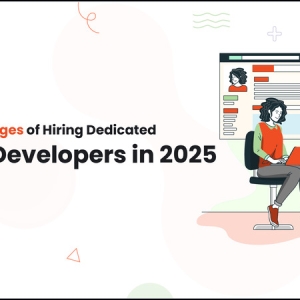Introduction
In 2025, IT staff augmentation is emerging as a strategic response to the growing challenge of building high-performing tech teams at speed. Traditional hiring models often can’t keep up with fast-moving product cycles, and delays in recruitment can stall innovation.
Companies now need to scale tech teams without taking on long-term headcount risk. Remote developer hiring has become the norm, not the exception, pushing businesses to rethink how and where they find talent.
This shift toward flexibility and global access is more than a trend. It’s a structural change in how companies approach growth and delivery. This blog explores how software product engineering services-based companies scale their tech teams!
What is IT Staff Augmentation?
IT staff augmentation is a flexible hiring approach where companies onboard external developers or tech specialists temporarily to meet evolving project demands. It’s a strategic choice for scaling tech teams without committing to full-time hires or long recruitment cycles.
Unlike outsourcing, where control often shifts externally, or freelancing, where engagement is minimal, staff augmentation offers embedded support while retaining internal control. The result is a hybrid workforce aligned with your product goals and sprint schedules.
Many businesses confuse it with outsourcing because of the external nature of talent. But the difference lies in operational integration. Augmented staff use your tools, attend your standups, and follow your roadmap.
Organizations often turn to this model to fix common scaling challenges, such as sudden team bandwidth issues, gaps in technical expertise, or the need to launch faster without overloading internal staff.
Staff Augmentation Trends 2025: What’s Driving the Shift?
The surge in IT staff augmentation isn’t accidental. In 2025, businesses of all sizes are actively seeking smarter ways to scale tech operations without being burdened by traditional hiring models. Here are five key drivers fueling this shift.
According to Deloitte’s 2024 Tech Talent Outlook, 74% of companies will rely on staff augmentation for critical tech projects by 2025. This reflects how quickly businesses are adapting to new realities where agility, not size, defines success!
Real-World Use Cases: Where Staff Augmentation Works Best?
IT staff augmentation proves most valuable when teams need to stay lean yet move fast. Here are four high-impact use cases where it delivers exceptional results:
1. MVP Development (Startups)
Startups often need to validate product ideas quickly without the drag of hiring full-time engineers. Augmenting the team with skilled developers allows them to build, iterate, and launch MVPs within tight investor-driven timelines.
2. Agile Product Iterations (SaaS)
SaaS companies live sprint-to-sprint. Bringing in temporary specialists through IT staff augmentation helps accelerate release cycles without overwhelming internal teams. Developers can plug into sprint planning and ship updates faster.
3. Digital Transformation (Enterprise)
Enterprises migrating from legacy systems or replatforming major products often require niche expertise in modern frameworks. Instead of hiring full-time, they use IT staff augmentation to fill capability gaps during the transformation phase.
4. DevOps and Cloud Modernization Projects
Infrastructure modernization demands fast access to specialized cloud, CI/CD, or automation skill sets. Augmenting your team ensures these tasks are completed without derailing core engineering focus.
Real Use Case—Acquaint Softtech
A fast-growing PropTech company was experiencing frequent sprint delays while building a modular property listing platform. Their in-house developers were overextended, and they needed Laravel expertise to unblock critical backend workflows without pausing feature development.
Instead of initiating a lengthy recruitment cycle, the company partnered with Acquaint Softtech to augment its IT staff. Within 48 hours, a senior Laravel developer was embedded into their product team. Using Notion, Jira, and Slack, the developer aligned quickly with sprint planning and Git-based workflows.
Over the next three sprints, the company reported:
- A 45% reduction in backend sprint delays
- Faster bug resolution during UAT
- Improved release velocity without impacting internal roadmap ownership
This outcome was achieved without increasing long-term headcount or HR overhead. The augmented developer worked as an extension of their existing team, contributing to standups, documentation, and delivery cycles like a full-time member.
How IT Staff Augmentation Helps Scale Tech Teams Without Overload?
One of the biggest challenges for CTOs in 2025 is how to scale tech teams 2025 without slowing them down. More developers don’t always mean more output, especially when full-time hiring adds overhead, onboarding delays, and budget rigidity.
This is where IT staff augmentation excels.
By embedding skilled contributors into ongoing workflows, companies can temporarily expand their execution capacity without disrupting internal dynamics. You don’t need to build large departments to deliver large results. Instead, you bring in the right expertise at the right moment and disengage when the sprint or feature is done.
There’s no training curve, no long-term contract, and no recruitment bottleneck. With remote communication tools like Slack, Notion, and Loom, augmented talent fits into daily operations almost instantly.
In short, you can hire remote developers to boost delivery speed, increase feature throughput, and keep your core team focused on long-term goals—all without adding stress to your internal systems.
Comparing In-House vs. IT Staff Augmentation
Choosing between expanding your internal team or extending it temporarily is a strategic decision. Understanding the trade-offs in cost, speed, flexibility, and scalability can help clarify the best fit for your business.
In 2025, tech leaders prefer to optimize for adaptability. IT staff augmentation allows you to scale delivery without expanding permanent headcount, which makes it ideal for sprint-based or high-urgency product teams.
Let’s look at the core differences in IT staff augmentation vs in-house hiring.
Key Mistakes Companies Make (And How to Avoid Them)
Adopting IT staff augmentation without internal readiness often leads to disappointment, even when the talent is exceptional. Companies excited by the promise of faster hiring and global reach sometimes make mistakes that reduce system efficiency.
One of the most common errors is treating augmented developers as outsiders. They are often excluded from meetings, not given access to documentation, or left out of communication loops. This weakens alignment and delays delivery.
Teams also fail to document roles, sprint goals, or workflows clearly, leading to repeated rework and confusion. Over-dependence is another hidden risk—when augmented staff are not supported by a capable internal team, knowledge gaps start to form.
Remote Developer Hiring Challenges
Remote setups magnify these issues. Without strong onboarding, tool integration, and team rituals, even skilled developers struggle to deliver at their full potential.
Tip: Solve this with structured onboarding, clear documentation, and seamless inclusion into your sprint rituals and daily workflows.
How Acquaint Softtech Powers Scaling With IT Staff Augmentation?
At Acquaint Softtech, we’ve helped startups, enterprises, and SaaS companies scale product delivery through expert-led IT staff augmentation. Our model is built for speed, flexibility, and tech excellence.
We are an official partner of Laravel, Statamic, and Bagisto, giving us direct access to community standards and core framework updates. With over 70 skilled developers on the bench, we provide companies with quick access to specialized talent, including backend architects, full-stack engineers, QA testers, and DevOps professionals.
You can hire Laravel developers starting at $15/hour, onboarded within 48 hours. Every developer is aligned with sprint planning, reporting rituals, and technical architecture reviews. Dedicated delivery heads ensure your goals are met, on time and on spec.
Case Studies by Acquaint Softtech
- SuperFi (Fintech): Embedded a React + Laravel team for continuous delivery in a high-compliance environment
- Elite (eLearning): Helped reduce dev backlog by 40% with 3 remote engineers.
- Real School (EdTech): Built microservice-based backend with integrated QA, enabling 2x faster release cycles
Future of IT Staff Augmentation: What’s Next?
As hiring models continue to evolve, IT staff augmentation is not only becoming mainstream but also more intelligent and platform-driven. With the rise of AI-matching tools and staffing marketplaces, the next evolution will be about precision, not just filling roles, but aligning developers with team culture, velocity, and tech stack in real time.
We’re also seeing a shift toward hybrid models, where companies blend managed services with augmentation to cover both delivery and flexibility. CTOs now prefer monthly retainer setups over full-time contracts, enabling them to lock in critical skills without locking down budgets.
Long-term, staff augmentation will transition from being a temporary fix to becoming a core hiring pillar, especially in agile-driven and globally distributed teams. As more companies focus on embedded collaboration and deep product ownership, augmented developers will no longer be “contractors”, they’ll be strategic partners.
Bottomline
As 2025 unfolds, one truth is clear—speed, flexibility, and access define the future of technical hiring. IT staff augmentation is no longer a workaround, it’s a long-term strategy for companies that want to move fast without overextending their teams.
We’ve seen how this model solves real product bottlenecks, fills skill gaps, and offers cost efficiency that traditional hiring struggles to match. Whether it’s launching an MVP, scaling a SaaS platform, or executing enterprise transformation, augmentation delivers focused expertise right when it's needed.
As staff augmentation models mature with AI, global access, and hybrid engagement formats, now is the time for tech leaders to rethink how they build, not just what they build. The smartest growth starts with hiring that adapts as fast as your roadmap.
Source :
https://medium.com/@mukesh.ram/how-it-staff-augmentation-is-scaling-tech-teams-in-2025-649a0f66f04a




